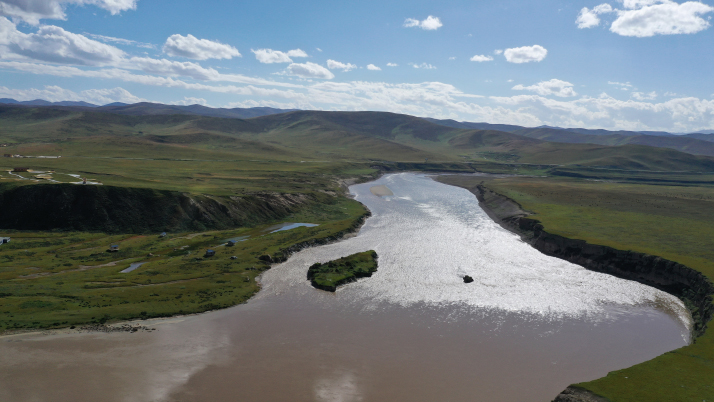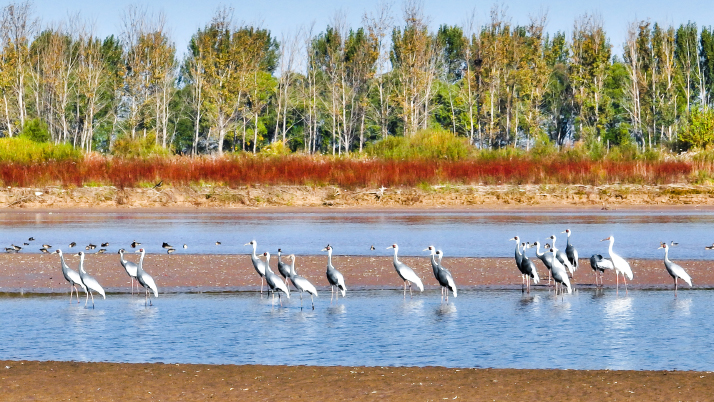| China |
| New law ensures Yellow River protection | |
|
|
 The Yellow River flows through Maqu County of Gannan Tibetan Autonomous Prefecture in Gansu Province on September 21 (XINHUA)
The Yellow River, the nation's second longest river, is known not only as the Cradle of Chinese Civilization, but also as a vast ecological corridor that has supported the flourishing of plants, animals and humans since the depths of prehistory. From its source on the Qinghai-Tibet Plateau, China's Mother River winds through the Inner Mongolia Plateau, the Loess Plateau and the North China Plain before reaching the coast at the Bohai Sea after a journey of 5,464 km.
After thousands of years of utilization and exploitation, the Yellow River Basin now faces environmental challenges including soil erosion, pollution and periods of insufficient flow alternating with periods of flooding. The impacts of these challenges are felt not only by those who depend on the river for their livelihoods, but also by the people who call the basin home. According to Xinhua News Agency, some 420 million people, or nearly 30 percent of China's population, were living in the nine provinces and autonomous regions the river passes through as of late 2018. These challenges also have broader impacts on China's environment, society and economy and, to overcome them, the Standing Committee of the National People's Congress (NPC), China's top legislature, voted on October 30 to adopt the Yellow River Protection Law, which will come into effect on April 1, 2023. The law came on the heels of the Yangtze River Protection Law, which took effect in March last year. Both laws were passed as part of national efforts to manage water on a river-by-river basis.  White-naped cranes at the Yellow River Delta National Nature Reserve in Dongying, Shandong Province, on October 18 (XINHUA)
Sustainable development "The Yellow River Basin is home to many high-resource-consumption and high-emission industries such as coal and non-ferrous metal smelting, and excessive water use in agriculture and industry has placed heavy pressure on the environment," Wang Xiahui, deputy chief engineer at the Chinese Academy of Environmental Planning, told China Environment News. "If the region doesn't transform its economic development model and restore the environment, it will face the risk of severe ecological degradation." The new law stipulates these industries and the basin's development model as a whole must be commensurate with the carrying capacity of the ecological system, and strict restrictions will be placed on the presence and activities of these industries along the main river and its tributaries. Company-specific clean production initiatives that minimize waste and emissions will be introduced in the basin's industries, including coal, thermal power, iron and steel, coking, chemical and nonferrous metal industries. The law further states that government at or above the county level must promote high-quality development within the manufacturing industry and resource-based industries, develop more modern industries, and promote cleaner and lower-carbon development in line with national carbon peaking and neutrality goals. "Strictly banning the establishment of industries with high energy and water consumption or high pollution along the main stream and tributaries of the river serves to curb environmental damage at its source," Dou Shuhua, a member of the NPC's Environmental Protection and Resources Conservation Committee, told Beijing-based Guangming Daily. Although it is China's second longest river, the Yellow River's catchment areas collect just about 2 percent of the nation's river runoff. As demand for water increases with economic development, protection of the Yellow River's limited water will now be guaranteed by law. Planning for urban development, land use, population and industry and agriculture will be legally required to adhere to sustainable water use limits. The law also encourages the adoption of water-saving technologies and lifestyle practices. In addition to saving water, the legislation makes provisions for the prevention and control of water pollution, codifying standards for the transport and treatment of agricultural and industrial pollutants. In recent years, provinces and autonomous regions along the river have made efforts to prevent and control water pollution. One notable example is the Yellow River's second largest tributary, the Fenhe River. The river has long been known as the Mother River of Shanxi Province for its nurturing of the population there since before the beginning of agriculture. However, overuse, decreased vegetation coverage and industrial pollution would leave the river dry for most of the year and putrid for the rest of it. The provincial government began restoring the river's flow and ecology in 2017. A water diversion project began to transfer water from the upper reaches of the Yellow River into the Fenhe River that year, with water lifted by several pumping stations and diverted to the Fenhe River at its source in Ningwu County. This effort and others that have followed, including the appointment of river chiefs to monitor sections of the river, have seen increases in water volume, water quality and wildlife. Flooding is the biggest threat to the Yellow River Basin. Due to a lack of vegetation, the Loess Plateau in the middle reaches of the river is particularly susceptible to soil erosion. Historically, the depositing of these yellow loess sediments on the plains along the lower reaches of the river during times of flood has been the key to the region's enduring fertility. This sediment also gives the river its name. However, the successively high levees built to prevent these floods and the accumulation of sediment inside them have seen the height of the riverbed surpass that of the surrounding cities and farmlands, leading it to be known as the "Hanging River" or "Above-ground River." "The key to preventing floods is water and sediment control," Yuan Jie, an official with the NPC Standing Committee's Legislative Affairs Commission, said. The new law stipulates the improvement of the water and sediment control system, with a focus on major water projects such as key reservoirs. Also included in the law are provisions for coordinated water and sediment control between agencies and administrative regions. In addition to coordination on flood and sediment control, the legislation will establish a mechanism for coordination between administrative regions on environmental protection and high-quality development within the basin. Unified systems for monitoring the environment, natural resources, natural disasters and meteorology in the basin will also be established under the law. Preserving culture It is widely believed the Yellow River Basin is the birthplace of China's first dynasty, the Xia (roughly 2070-1600 B.C.). Thousands of years of continuous settlement and the rise and fall of kingdoms have left a profound cultural heritage in the region, including as of yet innumerable historical artifacts. Accordingly, the law includes provisions for the protection, transmission and promotion of Yellow River Culture. The law sets out standards for the protection of cities, towns and villages of historical and cultural significance, as well as cultural relics, historical architecture, ancient dikes and irrigation projects in the basin. It specifies the establishment of a Yellow River National Culture Park; coordination of the operation of cultural heritage sites, museums, memorials and other resources; and the application of information technologies to record, preserve and display the culture. Jidi Majia, a member of the NPC Standing Committee, told Guangming Daily that the Yellow River is not only a type of natural heritage but also a kind of spiritual heritage of the Chinese nation. Its culture must be protected. (Print Edition Title: There She Flows) Copyedited by G.P. Wilson Comments to jijing@cicgamericas.com |
|
||||||||||||||||||||||||||||
|